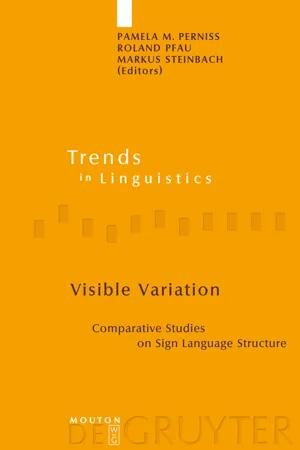
- 413 pages
- English
- PDF
- Available on iOS & Android
About This Book
It has been argued that properties of the visual-gestural modality impose a homogenizing effect on sign languages, leading to less structural variation in sign language structure as compared to spoken language structure. However, until recently, research on sign languages was limited to a number of (Western) sign languages. Before we can truly answer the question of whether modality effects do indeed cause less structural variation, it is necessary to investigate the similarities and differences that exist between sign languages in more detail and, especially, to include in this investigation less studied sign languages.
The current research climate is testimony to a surge of interest in the study of a geographically more diverse range of sign languages. The volume reflects that climate and brings together work by scholars engaging in comparative sign linguistics research. The 11 articles discuss data from many different signed and spoken languages and cover a wide range of topics from different areas of grammar including phonology (word pictures), morphology (pronouns, negation, and auxiliaries), syntax (word order, interrogative clauses, auxiliaries, negation, and referential shift) and pragmatics (modal meaning and referential shift). In addition to this, the contributions address psycholinguistic issues, aspects of language change, and issues concerning data collection in sign languages, thereby providing methodological guidelines for further research. Although some papers use a specific theoretical framework for analyzing the data, the volume clearly focuses on empirical and descriptive aspects of sign language variation.
Frequently asked questions
Information
Table of contents
- Frontmatter
- Table of contents
- Notational conventions
- Can’t you see the difference? Sources of variation in sign language structure
- Occurrence of mouthings in American Sign Language: A preliminary study
- Do all pronouns point? Indexicality of first person plural pronouns in BSL and ASL
- Negation in Jordanian Sign Language: A cross-linguistic perspective
- On the syntax of negation and modals in Catalan Sign Language and German Sign Language
- ‘Real data are messy’: Considering cross-linguistic analysis of constituent ordering in Auslan, VGT, and ISL
- Cross-linguistic comparison of interrogatives in Croatian, Austrian, and American Sign Languages
- The expression of modal meaning in German Sign Language and Irish Sign Language
- Reported action in Nicaraguan and American Sign Languages: Emerging versus established systems
- Grammaticalization of auxiliaries in sign languages
- The possible range of variation between sign languages: Universal Grammar, modality, and typological aspects
- Backmatter